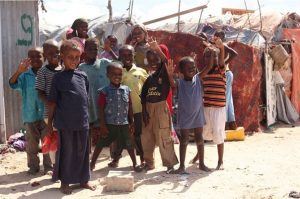
WHO/T.Moran
14 June, 2013 – The year 2005 saw one of the worst polio outbreaks in recent memory. Polio from northern Nigeria spread across west and central Africa, through Yemen, Saudi Arabia and all the way to Indonesia. That year, more than a thousand cases were reported in countries that had previously been polio-free. The international community knew that something had to be done.
So in May 2006, the member states of the World Health Assembly came together to pass a resolution setting out the ideal response to new polio outbreaks. The resulting resolution, WHA59.1, is still the foundation of response planning today. However, with each subsequent outbreak, the poliovirus has delivered some important lessons – lessons which are being used to inform the response to the outbreak in the Horn of Africa right now.
It didn’t take long for the strategies of the 2006 resolution to be put to the test. The same month that the resolution was passed, an outbreak occurred in Namibia. While the Namibian Government responded quickly and in line with the resolution’s recommendations, the virus had already been quietly spreading, undetected, for some time. The 2006 outbreak in Namibia underlined the need for polio-free countries to maintain surveillance and to keep up routine immunization rates across the country – ensuring that every community receives the same protection.
The experience in Namibia also taught the Global Polio Eradication Initiative (GPEI) that outbreaks in previously polio-free countries were becoming even more deadly. Unlike previous outbreaks, which had predominantly affected children under the age of five, the outbreak in Namibia in 2006 primarily affected young adult males over 15 years of age. And with that increase in adult cases sadly came an increase in the number of deaths, as polio is more deadly for adults than for children. This pattern was to be seen in other outbreaks, including the particularly devastating outbreak that affected the Republic of Congo at the end of 2010.
In the Congo, like in Namibia, there was a group of young adults who had not had the chance to gain natural immunity from exposure to the wild virus (since they had grown up during the time their country had been polio-free) but were already older than five when the country had made a concerted effort to improve immunization rates. So when polio reached these unfortunate people in the Congo, the consequences were shocking. More than 100 deaths were recorded – mostly young men and women in the prime of their lives. With each new outbreak in a previously polio-free country it was becoming increasingly clear: vaccinating children under five would not be enough to put a stop to the virus, rather the target population would have to be defined according to the prevailing pattern of cases and the country’s immunization history. The need to eradicate polio completely became all the more urgent. In fact, mathematical modelling indicates that if we do not complete the job of polio eradication, the disease will come roaring back. Within ten years, the world could again see 200,000 new cases all over the globe – every single year! This would be a humanitarian catastrophe that must be averted at all costs.
The same year the Republic of Congo was dealing with their deadly outbreak, polio reared its ugly head in an unexpected place: Tajikistan. Proving that polio anywhere really is a threat everywhere, the virus found its way to a pocket of unprotected children in a relatively developed country. A year later, the same thing happened in China, demonstrating that while good national surveillance and immunization coverage indicators are all well and good, what really matters is consistent performance at the subnational level.
With the 2006 ‘gold standard’ outbreak response guidelines and the experience that each outbreak has brought, GPEI is now much better prepared to deal with new outbreaks. Since 2010, all but one new outbreak of wild poliovirus was stoped within six months. In fact, an outbreak in Niger in late 2012 was limited to just one case. However, if there is just one lesson to take away from the examples mentioned above, it’s that the poliovirus is constantly finding new ways to thwart those who would seek to end it. Until polio is eradicated, outbreaks will continue to occur.



